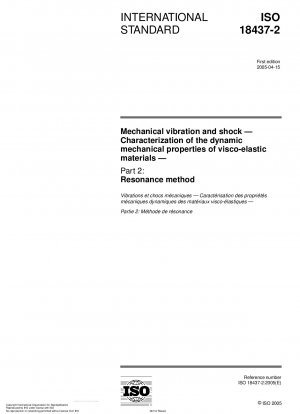ISO 18437-2:2005
Mechanical vibration and shock - Characterization of the dynamic mechanical properties of visco-elastic materials - Part 2: Resonance method
- Standard No.
- ISO 18437-2:2005
- Release Date
- 2005
- Published By
- International Organization for Standardization (ISO)
- Status
- 2010-09
- Replace By
- ISO 18437-2:2005/Amd 1:2010
- Latest
- ISO 18437-2:2005/Amd 1:2010
- Scope
- This part of ISO 18437 defines a resonance method for determining from laboratory, measurements the dynamic mechanical properties of the resilient materials used in vibration isolators. It is applicable to shock and vibration systems operating from a fraction of a hertz to about 20 kHz.
This part of ISO 18437 is applicable to resilient materials that are used in vibration isolators in order to reduce
a) transmissions of unwanted vibrations from machines, structures or vehicles that radiate sound (fluid-borne, airborne, structure-borne, or others), and
b) the transmission of low-frequency vibrations that act upon humans or cause damage to structures or sensitive equipment when the vibration is too severe.
The data obtained with the measurement methods that are outlined in this part of ISO 18437 and further detailed in ISO 18437-3 are used for
— the design of efficient vibration isolators,
— the selection of an optimum material for a given design,
— the theoretical computation of the transfer of vibrations through isolators,
— information during product development,
— product information provided by manufacturers and suppliers, and
— quality control.
The condition for the validity of the measurement method is linearity of the vibrational behaviour of the isolator. This includes elastic elements with nonlinear static load deflection characteristics, provided that the elements show approximate linearity in their vibrational behaviour for a given static preload.
Measurements using this method are made over one or two decades in frequency at a number of temperatures. By applying the time-temperature superposition principle, the measured data are shifted to generate dynamic mechanical properties over a much wider range of frequencies (typically 10
to 10 Hz at a single reference temperature) than initially measured at a given temperature. NOTE For the purposes of this part of ISO 18437, the term "dynamic mechanical properties" refers to the determination of the fundamental elastic properties, e.g. the complex Young's modulus as a function of temperature and frequency and, if applicable, a static preload.
ISO 18437-2:2005 Referenced Document
- ISO 10112:1991 Damping materials; graphical presentation of the complex modulus
- ISO 10846-1:1997 Acoustics and vibration - Laboratory measurement of vibro-acoustic transfer properties of resilient elements - Part 1: Principles and guidelines
- ISO 2041:1990 Vibration and shock; vocabulary
- ISO 23529:2004 Rubber - General procedures for preparing and conditioning test pieces for physical test methods
- ISO 4664-1:2005 Rubber, vulcanized or thermoplastic - Determination of dynamic properties - Part 1: General guidance
- ISO 472:1999 Plastics - Vocabulary
- ISO 6721-1:2001 Plastics - Determination of dynamic mechanical properties - Part 1: General principles
ISO 18437-2:2005 history
- 2010 ISO 18437-2:2005/Amd 1:2010 Mechanical vibration and shock - Characterization of the dynamic mechanical properties of visco-elastic materials - Part 2: Resonance method; Amendment 1
- 2005 ISO 18437-2:2005 Mechanical vibration and shock - Characterization of the dynamic mechanical properties of visco-elastic materials - Part 2: Resonance method
